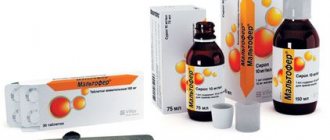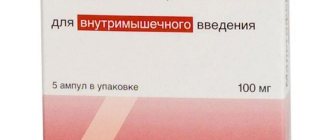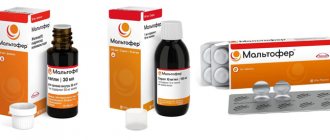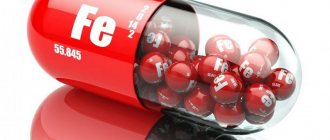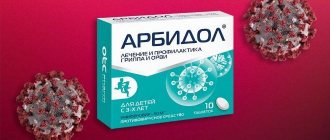Maltofer: the optimal form for taking iron. For the treatment and prevention of anemia
Iron is a key element for the body. It is part of the structure of hemoglobin and myoglobin (muscle hemoglobin). Plays an important role in metabolism. Its deficiency leads to a disease - anemia.
Iron deficiency disrupts the oxygen supply to cells. Because of this, immunity decreases and the risk of infectious diseases increases. The epithelium of the skin and mucous membranes throughout the body, including in the digestive tract, is affected. The likelihood of intestinal infections and acute respiratory viral infections with iron deficiency increases by 1.5 - 2 times. Eczema and other skin pathologies develop, blood pressure is disturbed, and tachycardia occurs.
The human body is not able to produce iron and can only obtain it from an external source - from food. Therefore, it makes sense to follow a balanced menu and include foods containing iron.
And accelerated therapy is carried out with the help of iron-replenishing drugs, such as Maltofer.
What is Maltofer
Maltofer is a medicinal product created to replenish:
- Iron deficiency in iron deficiency anemia;
- Iron reserves in case of increased need.
Maltofer contains iron trihydroxide, which is considered one of the most effective and safe iron compounds.
It matters a lot in what form the iron element is taken, and in what compound.
Ferric iron contains a polymaltose complex and has the following properties:
- There is no risk of overdose, poisoning or intoxication;
- Does not stain teeth and gums;
- Does not interact with medicine and food;
- Has antioxidant properties;
- Gives positive results from the first days of use;
- It has a pleasant taste and is accepted with pleasure by children;
- Available in a variety of forms to suit everyone.
The advantage of Maltofer is that iron is in a stable macromolecular complex and does not release the element as free ions in the gastrointestinal tract. Thanks to this, iron moves from the intestines into the blood through active transport.
After digestion, iron binds to ferritinin and is deposited in the body, mainly in the liver.
According to the publication of oncologists, oral administration of iron supplements is a more physiological way of replenishing the deficiency. In addition, it is even more secure and, last but not least, cheaper.
Analogs
Maltofer analogues include:
- Fermed (solution administered intravenously). Effective for anemia, iron deficiency and high need for it (with the exclusion of meat products from the diet, in old age, with the donation of blood components, lactation and pregnancy).
- Ferrum Lek. Indicated for young children and adults.
- Ferlatum. Antianemic drug containing iron protein succinylate. A solution is available for oral use. The medicine is not prescribed for non-iron deficiency anemia, intolerance, cirrhosis, chronic inflammation of the pancreas, hemochromatosis.
- Sorbifer Durules. The drug should not be prescribed to infants and children under 12 years of age. It contains vitamin C and iron sulfate. The drug is contraindicated in case of narrowing of the esophagus, children under 12 years of age, hypersensitivity and excess iron.
- Ferretab Comp. This iron supplement is available in the form of long-acting capsules. Contains iron fumarate and vitamin B9. Prescribed for pregnancy, microelement malabsorption, bleeding and poor nutrition.
- Fenyuls. A complex preparation containing iron sulfate and vitamins. Taken orally in capsule form.
Types of Maltofer
Maltofer is an iron supplement from Vifor, France, which comes in three forms.
- Maltofer Syrup, 150 ml package. Suitable for all ages including babies;
- Maltofer drops, 30 ml package. Suitable for all patients, like Maltofer syrup, plus one additional group - premature babies;
- Maltofer Fol, chewable tablets. Pack of 30 pcs.
Chewable tablets can also be swallowed whole. They are a suitable form for adult patients and are especially popular with children who can already chew.
Side effects
Solution for intramuscular administration
Rarely - arthralgia, swollen lymph nodes, fever, headache, dyspepsia (nausea, vomiting) are possible.
Very rarely - allergic or anaphylactic reactions are possible.
Local reactions (if the drug is administered incorrectly): skin coloring, pain at the injection site, inflammation.
Oral drops, Syrup, Chewable tablets, Oral solution
On the part of the gastrointestinal tract: a feeling of fullness, pressure in the epigastric region, nausea, constipation or diarrhea; dark stool may be stained due to the release of unabsorbed iron, which has no clinical significance.
In what cases and how to take it
Maltofer is prescribed for iron deficiency. This includes several cases:
Iron deficiency without anemia (latent iron deficiency)
At the initial stages, iron deficiency remains hidden. But after a while, specific symptoms inevitably begin to appear: lethargy, rapid onset of fatigue, weakness, dizziness.
With a significant deficiency, ringing in the ears and spots before the eyes appear. Women immediately notice that their hair becomes dry and falls out when combing.
For men, iron deficiency is even more problematic because they are exposed to more physical activity. Even the slightest activity leads to increased heart rate and shortness of breath.
Children have decreased immunity, pale and dry skin, and loss of appetite. Smoothing of the lingual papillae immediately indicates that there is not enough iron in the body. But parents immediately notice memory deterioration.
With prolonged deficiency, all these symptoms worsen.
To find out about iron deficiency before symptoms appear, test your blood for 6 months.
How to use Maltofer
For latent iron deficiency and for prevention, the following are prescribed (daily dose):
Drops
- For children under 1 year - 6-10 pcs.;
- 1-12 years - 10 - 20 pcs.;
- Adults, including pregnant women - 20-40 pcs.
Syrup
Treatment of iron deficiency with normal red blood cell counts and prevention of iron deficiency:
- 1-12 years - 2.5 - 5 ml;
- Over 12 years - 5-10 ml;
- Pregnant women - 10 ml.
Children under 1 year of age are treated only with drops because they are formulated in an appropriate concentration, while the syrup cannot be measured in an appropriate low dose.
Treatment lasts 1-2 months.
Pills
1 PC. for all patients.
Treatment of clinically significant iron deficiency anemia
Such anemia occurs with acute iron deficiency and with systematic non-compliance with the amount to make up for the deficiency. The condition combines signs of anemia and iron deficiency in tissues.
There are two periods in the development of the disease:
- Period of hidden deficit;
- Period of severe anemia.
Even in the initial stage, weakness, malaise, dry tongue, rapid heartbeat, shortness of breath, dryness and burning of the vulva in women are felt.
In the second stage, hair loss and graying begin, the skin becomes rough and dry, the nails become thinner and take the shape of a boat.
Patients often suffer from headaches, dizziness, confusion, and drowsiness.
In severe anemia, loss of consciousness occurs.
The severity of symptoms does not depend on the degree of anemia, but on the duration of the disease and the age of the patient.
When the missing iron is replenished, the symptoms disappear.
More than 1.62 billion people on Earth—24.8 percent of the population—suffer from anemia. The majority are children under 7 years of age - 47.4 percent of all patients.
Therapy with Maltofer
Drops
- For premature babies - 1-2 pcs., course 3-5 months;
- Up to 1 year - 10-20 pcs.;
- 1-12 years - 20-40 pcs.;
- More than 12 years, including pregnant women - 40-120 pcs.
Syrup
- Up to 1 year - 2.5 - 5 ml;
- 1-12 years - 5-10 ml;
- Over 12 years, pregnant women - 10 - 30 ml.
Pills
1-3 pcs. per day, for pregnant women - 2-3 pcs.
special instructions
When taking medication, you need to consider the following:
- Maltofer is taken only after the etiological factor has been eliminated (if the deficiency is due to tumors or infection).
- When using the medicine, there is a risk of damage to tooth enamel.
- Substances included in the drug sometimes cause allergies
- There are no data on the effect of Maltofer on pregnant women and the fetus in the 1st trimester.
- A negative effect of drops on the fetus is unlikely.
- The drug is prescribed with caution to people with liver pathology (liver failure, cirrhosis, hepatitis).
- The effect on the body of a nursing mother has not been sufficiently studied. Negative impact is unlikely.
- It is recommended to give Maltofer to infants in the form of drops.
Read more Aktiferrin drops: instructions for use and reviews
Price and expiration date
Maltofer drops are available with a prescription. The minimum cost is 220 rubles. The injection solution costs from 1,200 rubles, and the average price for syrup is 260 rubles. Drops are stored in a dark place. Children's access to them should be prohibited. The optimal temperature is below 25ºC.
Drops are valid for 3 years. Once opened, Maltofer cannot be stored for long.
Interaction with other drugs
Maltofer drops or syrup should not be combined with parenteral administration of iron-containing solutions, since the absorption of oral agents slows down. When performing injections, it is not advisable to take ACE inhibitors due to the enhanced effect of the drug.
Increased need for iron
The need for iron increases in the following physiological or exceptional circumstances:
- Pregnancy;
- Strict diet, fasting;
- Breast-feeding;
- Blood donation;
- Intensive growth;
- vegetarianism;
- Senile age.
If pregnant women's hemoglobin levels decrease, there is a risk of a number of pathologies in the fetus.
Even more dangerous is iron deficiency in children: mental development can slow down.
Schoolchildren have difficulty concentrating, study poorly, and their performance declines.
In all groups, sleep, appetite, mood and psyche suffer. With iron deficiency, patients become whiny, nervous, and moody.
How long to drink: replenishing the deficiency requires long-term use. Typically varies from 1 to 5 months. The duration is determined by the specialist in accordance with the condition/research results.
Indications for use
The reasons for using the drug are:
- Iron deficiency. The daily intake of the element from food is 10 mg for men and 18 mg for women. The norm for children varies from 0.27 mg (for newborns) to 15 mg for teenage girls.
- Iron-deficiency anemia. It can develop against the background of blood loss, internal bleeding, ulcers, helminthiasis, hemosiderosis, diathesis, blood diseases, malnutrition (insufficient consumption of meat products), chronic diseases of the intestines and stomach.
- High need for microelements during pregnancy. During pregnancy, the rate of iron consumption increases due to increased metabolic processes and blood flow.
Read more Remo Vax ear drops - instructions and reviews
Iron-rich foods
Iron deficiency is mainly caused by an unbalanced diet. When the consumption of meat, fish, organ meats, buckwheat, legumes and wheat bran stops or is critically reduced, iron deficiency occurs. Something similar happens in those losing weight and in children who prefer fruits, sweets and dairy products.
Some people take enough iron-containing foods, but their hemoglobin levels decrease.
Why? Because they drink coffee and tea, and they contain tannin, an element that interferes with the absorption of iron.
Additionally, it is not recommended to combine iron and calcium products as both elements are neutralized. For example, buckwheat with milk is a very tasty breakfast, but is in no way useful for replenishing iron deficiency.
Popular iron-rich foods:
- Liver;
- Beef;
- Chicken;
- Dried apricots;
- Apples;
- Spinach;
- Broccoli;
- Pork;
- Egg yolk;
- Shrimps;
- Raisin;
- Jacket potatoes;
- Watermelon.
Overdose
Maltofer cannot be overdosed. The degree of iron absorption is selective. If a sufficient amount of the element is present in the body, the absorption rate is automatically reduced to minimum levels.
The greater the iron deficiency, the greater the amount taken is absorbed.
In clinical practice, it was confirmed that even when taking 2000 mg of iron per 1 kg of weight, death did not occur.
The likelihood of an overdose increases with intramuscular administration, but this form of Maltofer is not sold in our country.
Contraindications
Solution for intramuscular administration
- hypersensitivity
- anemia not associated with iron deficiency (hemolytic, megaloblastic, caused by vitamin B12 deficiency)
- erythropoiesis disorders
- bone marrow hypoplasia
- excess iron in the body (hemochromatosis, hemosiderosis)
- Impaired iron utilization (sideroachrestic anemia, thalassemia, lead anemia, cutaneous porphyria tarda)
- Osler-Rendu-Weber syndrome
- chronic polyarthritis
- bronchial asthma
- infectious kidney diseases in the acute stage
- uncontrolled hyperparathyroidism
- decompensated cirrhosis of the liver
- infectious hepatitis
- use for intravenous administration
- I trimester of pregnancy
- children under 4 months of age (experience with the drug is limited).
With caution: impaired renal and/or liver function.
Oral drops, Syrup, Chewable tablets, Oral solution
- iron overload (eg hemosiderosis and hemochromatosis)
- Impaired iron utilization (lead anemia, sideroachrestic anemia)
- non-iron deficiency anemia (hemolytic or megaloblastic, caused by a lack of vitamin B12).

